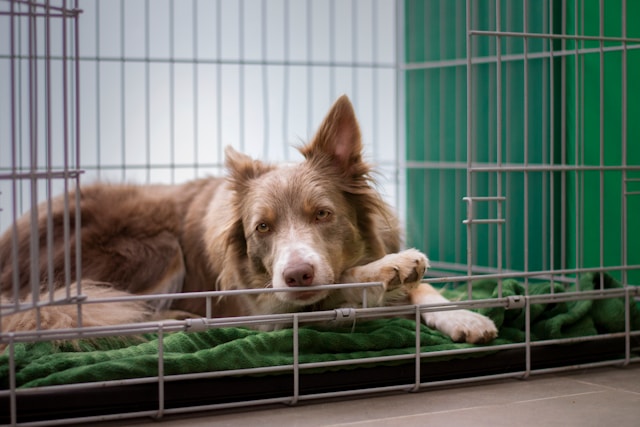The Pros and Cons of Crate Training What You Need to Know for Your Dog

Crate training is a popular method used by dog owners to manage their pets’ behavior and provide them with a safe, personal space. While many find it beneficial, it’s important to understand both the advantages and potential drawbacks of this approach. This comprehensive guide explores the pros and cons of crate training, helping you make an informed decision about whether it’s the right choice for your dog.
What is Crate Training?
Crate training involves teaching your dog to view a crate as a safe and comfortable space where they can relax. The crate serves as a den-like environment that can help with housebreaking, managing behavior, and providing security. A well-introduced crate can become your dog’s personal sanctuary, but it requires thoughtful implementation to be effective.
The Pros of Crate Training
- Housebreaking and Potty Training
- Encourages Routine: Crate training can help establish a regular potty routine. Dogs naturally avoid soiling their sleeping area, so using a crate can encourage them to hold it until they are let outside.
- Predictable Schedule: By following a consistent schedule of feeding, potty breaks, and crate time, you can reduce the likelihood of accidents in the house.
- Safety and Security
- Safe Space: A crate provides a safe and secure environment for your dog when you’re not able to supervise them. It prevents them from getting into dangerous situations or chewing on inappropriate items.
- Travel Safety: Crates can make car travel safer by keeping your dog contained and reducing distractions while driving.
- Managing Behavior
- Calm Environment: A crate can be a calming retreat for your dog when they’re feeling overwhelmed or overstimulated. It offers a quiet place where they can relax away from the hustle and bustle of the household.
- Training Aid: Crates can aid in training by providing a structured space where your dog can learn to settle down and focus.
- Preventing Destructive Behavior
- Controlled Access: By confining your dog to a crate when you’re not home, you can prevent them from engaging in destructive behaviors, such as chewing on furniture or getting into trash.
- Reducing Anxiety: A crate can help manage separation anxiety by providing a familiar, secure space that your dog associates with positive experiences.
- Facilitates Vet Visits and Boarding
- Adaptability: If your dog is accustomed to a crate, they may adjust more easily to being in a kennel or veterinary office where crates are commonly used. This familiarity can reduce stress during these situations.
The Cons of Crate Training
- Overuse and Misuse
- Isolation Concerns: Prolonged periods of confinement can lead to feelings of isolation and anxiety. It’s important not to use the crate as a form of punishment or to confine your dog for extended periods.
- Limited Socialization: Excessive crate time can limit your dog’s social interaction and exploration, which are crucial for their mental and emotional development.
- Initial Adjustment Period
- Training Challenges: Some dogs may resist crate training or take longer to adapt. This can require patience and consistency from the owner.
- Stress and Anxiety: If not introduced correctly, the crate can become a source of stress rather than comfort. It’s essential to ensure that the crate is associated with positive experiences.
- Health and Comfort Concerns
- Physical Health: If the crate is too small or doesn’t provide adequate ventilation, it can lead to physical discomfort or health issues. Ensure the crate is appropriately sized and well-ventilated.
- Mental Stimulation: Dogs need mental and physical stimulation. A crate should not be used as a substitute for exercise, play, and social interaction.
- Potential for Miscommunication
- Inconsistent Use: Inconsistent use of the crate can confuse your dog and hinder training progress. It’s important to establish a routine and use the crate consistently and positively.
- Misinterpretation: Without proper training, dogs may misinterpret the crate as a form of punishment or confinement, which can lead to fear and anxiety.
How to Implement Crate Training Effectively
- Choosing the Right Crate
- Size and Comfort: Select a crate that is appropriately sized for your dog, allowing them to stand, turn around, and lie down comfortably. Add a soft bedding to make it inviting.
- Material and Design: Opt for a crate made of durable, easy-to-clean materials. Wire crates provide good ventilation, while plastic crates offer more privacy.
- Positive Introduction
- Gradual Acclimation: Introduce the crate gradually. Start by placing treats, toys, and food inside the crate to create positive associations.
- Short Sessions: Begin with short periods of crate time and gradually increase the duration as your dog becomes more comfortable.
- Establishing a Routine
- Consistent Schedule: Incorporate the crate into your daily routine. Use it during nap times, at night, and when you leave the house to establish a sense of normalcy.
- Potty Breaks: Ensure regular potty breaks and avoid leaving your dog in the crate for extended periods. Puppies and elderly dogs may need more frequent breaks.
- Training and Reinforcement
- Positive Reinforcement: Reward your dog with praise and treats for entering and staying in the crate calmly. Avoid using the crate as a punishment.
- Gradual Independence: Encourage your dog to spend time in the crate with the door open, then gradually close the door for short periods as they adjust.
- Monitoring and Adjustment
- Observe Behavior: Monitor your dog’s behavior and comfort level in the crate. Make adjustments as needed to ensure they are not experiencing stress or discomfort.
- Seek Professional Help: If you encounter challenges or your dog shows signs of distress, consider seeking advice from a professional dog trainer or behaviorist.
Conclusion
Crate training can be a highly effective tool for managing your dog’s behavior, providing them with a sense of security, and aiding in housebreaking. However, it’s important to approach crate training with a clear understanding of both its benefits and potential drawbacks. By implementing crate training thoughtfully and ensuring your dog’s comfort and well-being, you can create a positive experience that enhances their quality of life.
Remember that crate training should be a part of a well-rounded care routine that includes exercise, socialization, and mental stimulation. With patience, consistency, and a positive approach, crate training can be a valuable asset in your dog’s overall training and care strategy.




